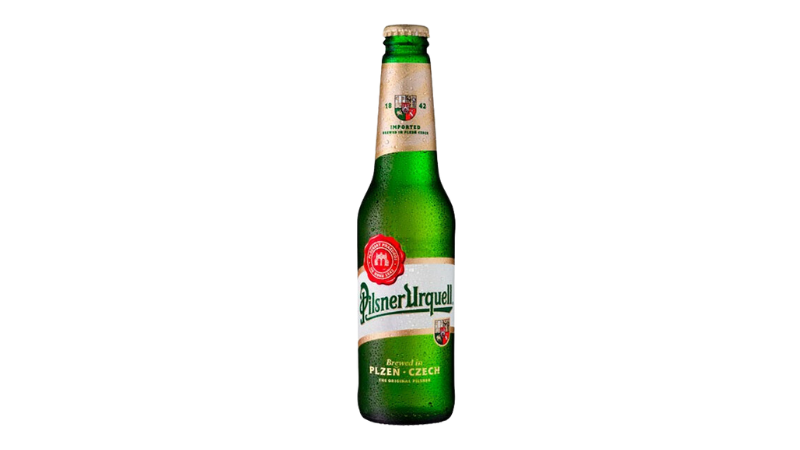Czech Pilsner vs German Pilsner | Everything You Need To Know
Originating from the Czech city of Pilsen in the early 19th century, Pilsner has grown to become one of the most popular and widely consumed styles of lager beer. While the Czech Pilsner is the most well-known, this style has inspired others, most notably the German Pilsner. In this guide, we will explain in detail the key differences between Czech Pilsners and German Pilsners, and show you many examples of each so you can fully understand how these differ. So, what’s the difference between Czech Pilsner and German Pilsner?
Czech and German Pilsners, while both golden lagers, differ mainly in flavor, ingredients, and brewing traditions. Czech Pilsners generally have a softer, more balanced profile with mild bitterness and a rounder malt sweetness and originate from the city of Pilsen in the Czech Republic. German Pilsners, on the other hand, are crisper and more bitter, featuring a cleaner, drier finish due to the use of noble hops like Hallertau and generally harder water. German Pilsners are more common in Germany.
Obviously, there are more nuanced differences between these beer styles. Keep on reading to find out how these beers differ in terms of history, ingredients, brewing process, flavor, and food pairings.
Czech vs German Pilsner: History
The story of Czech Pilsner begins in the city of Pilsen, located in what is now the Czech Republic, in 1842. Residents, dissatisfied with the quality of local beers, invited Bavarian brewer Josef Groll to apply his skills. Groll used local Saaz hops, soft Pilsen water, pale malt, and lager yeast to create a beer that was a revelation at the time: a clear, golden lager with a balanced flavor profile. This creation became the standard for the style and quickly gained international acclaim as Pilsner Urquell, the world’s first Pilsner.

German Pilsner has its roots in the influence of Czech Pilsner but took on its own identity as it spread across Germany. It gained prominence in the late 19th and early 20th centuries, especially in Northern Germany. German brewers adapted the Pilsner style to local tastes and water profiles, often utilizing harder water and noble German hops like Hallertau and Tettnanger. Over time, German Pilsners became known for their crispness, higher carbonation, and a more pronounced hop bitterness compared to their Czech counterparts.
Czech vs German Pilsner: Ingredients
One of the key differences between Czech and German Pilsners lies in their ingredients, which deeply influence their distinct flavors, aromas, and mouthfeels.
Czech Pilsner
The traditional Czech Pilsner recipe calls for a softer water profile, lending the beer a more rounded and balanced character. The use of Saaz hops, a variety that is native to the Czech Republic, imparts earthy and herbal tones to the beer. Czech Pilsners often utilize locally produced pale malts, which contribute to a balanced malt sweetness. The specific lager yeasts used in Czech brewing result in a beer with subtle fruity and complex malt characteristics.
German Pilsner
German Pilsners often feature harder water, which can accentuate hop bitterness, leading to a crisper finish. German noble hops like Hallertau, Tettnanger, and Spalt are commonly used, offering floral, spicy, and slightly citrusy notes. The malts in German Pilsners are also pale but are generally less sweet, creating a more austere and dry profile. German lager yeasts are selected for their clean fermenting characteristics, contributing to the beer’s overall cleaner, drier finish.
Czech vs German Pilsner: Brewing Process
Both Czech and German Pilsners undergo a similar brewing process involving mashing, boiling, fermentation, and lagering. However, there are some nuanced differences that contribute to their distinct profiles.
Czech Pilsner
The brewing process for Czech Pilsner often employs a traditional method known as decoction mashing. This involves removing a portion of the mash, boiling it, and then adding it back to the main mash. This method can enhance the malt character and depth of flavor.
The boiling phase for Czech Pilsners features Saaz hops and may involve a longer boil than many modern brewing styles, adding to the beer’s rounded profile. The fermentation typically occurs at cooler temperatures for an extended period, allowing the lager yeast to contribute its subtle complexities. To complete the brew, Czech Pilsners are often conditioned, or “lagered,” at very low temperatures for several weeks to months to produce a beer with a clean, smooth finish.
German Pilsner
German Pilsners often use a simpler, single-step infusion mash, contributing to a lighter, crisper body. The hops are generally added during the boil in a manner that extracts more bitterness, aligning with the style’s more pronounced hop character.
German Pilsners also ferment at cool temperatures but may not lager as long as Czech Pilsners, resulting in a cleaner, more straightforward flavor profile. Carbonation levels are often higher in German Pilsners, contributing to the style’s effervescence and crisp mouthfeel.

Czech vs German Pilsner: Flavor and Mouthfeel
While both Czech and German Pilsners are golden lagers that balance malt and hops, their flavors and mouthfeels have subtle but important differences that set them apart.
Czech Pilsner
Czech Pilsners are often described as having a balanced, rounded flavor profile. The malt sweetness is prominent but not overwhelming, creating a harmonious interplay with the earthy, herbal notes of Saaz hops. The soft water used in the brewing process accentuates the beer’s smoothness.
The mouthfeel is generally softer and fuller than German Pilsners, often described as “velvety” or “rounded.” Czech Pilsners tend to have a moderate carbonation level, which supports a fuller, more stable head. They’re often served at slightly warmer temperatures, which can further enhance their complex flavor profile.
German Pilsner
German Pilsners are characterized by a crisp and clean flavor profile. The hop bitterness is more pronounced, providing a sharp counterpoint to the malt. The harder water used in German Pilsners contributes to this crispness and brings out the floral, spicy characteristics of the noble hops.
In terms of mouthfeel, German Pilsners are generally lighter and more effervescent due to their higher carbonation levels. They are usually served colder, which complements their refreshing, crisp character.
Czech vs German Pilsner: Examples
To further illustrate the differences between Czech and German Pilsners, here are some examples of each style of beer.
Czech Pilsner Examples
- Pilsner Urquell – The original Pilsner, often considered the gold standard of the style.
- Budweiser Budvar (Czechvar in North America) – A classic example with a balanced profile.
- Staropramen – Known for its balanced maltiness and hop bitterness.
- Kozel Premium Lager – A lighter, easy-drinking Czech Pilsner.
- Bernard Pilsner – Features a more robust hop flavor than some other Czech Pilsners.
- Lobkowicz Premium Lager – Offers a mild bitterness and a slightly sweet malt profile.
- Gambrinus Original 10 – Named after the king of beer, it’s a lighter Czech Pilsner.
German Pilsner Examples
- Bitburger – A classic example featuring pronounced hop bitterness.
- Warsteiner Premium Verum – Known for its clean, crisp character.
- Jever – A particularly bitter and dry German Pilsner.
- Krombacher Pils – Offers a balance between malt sweetness and hop bitterness.
- Veltins Pilsener – Known for its sharp, refreshing finish.
- Radeberger – A well-balanced, slightly malty Pilsner.
- Holsten Pilsener – Features a floral hop aroma and a crisp finish.
Best Food Pairings For Pilsners
Whether you’re enjoying a Czech or German Pilsner, the right food pairing can elevate your beer-drinking experience. Here’s a look at foods that harmonize well with each style. If you would like to learn more about matching beer to food, check out our complete guide to beer-food pairing.
Czech Pilsner Pairings
- Grilled Sausages: The balanced nature of Czech Pilsners complements the spiciness and smokiness of grilled sausages.
- Fried Cheese: A Czech classic, fried cheese (or smažený sýr) works well with the beer’s rounded profile.
- Pork Schnitzel: The rich flavors of pork schnitzel balance nicely with the beer’s moderate bitterness.
- Goulash: A hearty Czech goulash can be a great match for the more robust, malty aspects of Czech Pilsners.
- Dumplings: Whether they’re potato or bread, dumplings pair beautifully with the beer’s fuller mouthfeel.
- Czech Potato Salad: The creamy, tangy flavors of a Czech-style potato salad work well with the balanced characteristics of Czech Pilsners.
German Pilsner Pairings
- Soft Pretzels: The salty, doughy goodness of a soft pretzel pairs excellently with the crispness of a German Pilsner.
- Bratwurst: The spiciness of bratwurst sausages complements the beer’s hoppy bitterness.
- Wiener Schnitzel: The crisp breadcrumb coating finds its match in the beer’s effervescent, crisp character.
- Spargel (White Asparagus): A traditional German dish, white asparagus works well with the clean, refreshing nature of German Pilsners.
- Pickled Herring: The sharp, vinegary flavors of pickled herring can be balanced by the beer’s crispness.
- Sauerkraut: The tangy, fermented flavors of sauerkraut make for a unique and complementary pairing with German Pilsners.
Wrapping Up
If you’ve made it this far, then you should have a good understanding of the difference between Czech and German Pilsners. While these beers have many similarities, there are also many differences that make them distinct from one another.

